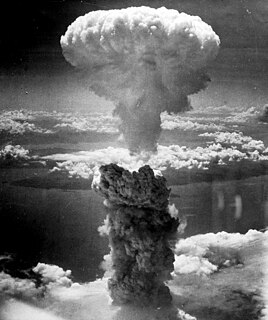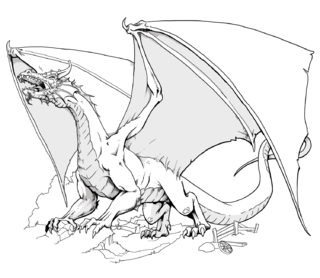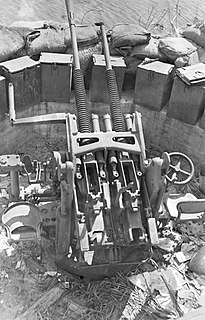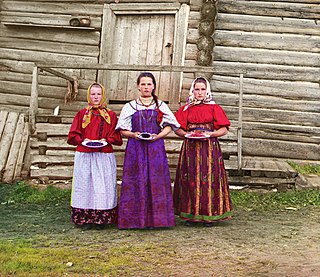
In modern language, a missile, also known as a guided missile, is a guided self-propelled system, as opposed to an unguided self-propelled munition, referred to as a rocket. Missiles have four system components: targeting or missile guidance, flight system, engine, and warhead. Missiles come in types adapted for different purposes: surface-to-surface and air-to-surface missiles, surface-to-air missiles, air-to-air missiles, and anti-satellite weapons. All known existing missiles are designed to be propelled during powered flight by chemical reactions inside a rocket engine, jet engine, or other type of engine. Non-self-propelled airborne explosive devices are generally referred to as shells and usually have a shorter range than missiles.

A machine gun is a fully automatic mounted or portable firearm designed to fire rifle cartridges in rapid succession from an ammunition belt or magazine for the purpose of suppressive fire. Not all fully automatic firearms are machine guns. Submachine guns, rifles, assault rifles, battle rifles, shotguns, pistols or cannons may be capable of fully automatic fire, but are not designed for sustained fire. As a class of military rapid-fire guns, machine guns are fully automatic weapons designed to be used as support weapons and generally used when attached to a mount- or fired from the ground on a bipod or tripod. Many machine guns also use belt feeding and open bolt operation, features not normally found on rifles.

A nuclear weapon is an explosive device that derives its destructive force from nuclear reactions, either fission or from a combination of fission and fusion reactions. Both bomb types release large quantities of energy from relatively small amounts of matter. The first test of a fission ("atomic") bomb released an amount of energy approximately equal to 20,000 tons of TNT (84 TJ). The first thermonuclear ("hydrogen") bomb test released energy approximately equal to 10 million tons of TNT (42 PJ). A thermonuclear weapon weighing little more than 2,400 pounds (1,100 kg) can release energy equal to more than 1.2 million tons of TNT (5.0 PJ). A nuclear device no larger than traditional bombs can devastate an entire city by blast, fire, and radiation. Since they are weapons of mass destruction, the proliferation of nuclear weapons is a focus of international relations policy.

A warhead is the explosive or toxic material that is delivered by a missile, rocket, or torpedo. It is a type of bomb.

A bomb is an explosive weapon that uses the exothermic reaction of an explosive material to provide an extremely sudden and violent release of energy. Detonations inflict damage principally through ground- and atmosphere-transmitted mechanical stress, the impact and penetration of pressure-driven projectiles, pressure damage, and explosion-generated effects. Bombs have been utilized since the 11th century starting in East Asia.
A longsword is a type of European sword characterized as having a cruciform hilt with a grip for two-handed use, a straight double-edged blade of around 85 to 110 cm, and weighing approximately 1 to 1.5 kg.

In the Dungeons & Dragons (D&D) fantasy role-playing game, dragons are an iconic type of monstrous creature used as adversaries or, less commonly, allies of player characters. As a group, D&D dragons are loosely based upon dragons from a wide range of fictional and mythological sources.
A club is among the simplest of all weapons: a short staff or stick, usually made of wood, wielded as a weapon since prehistoric times. There are several examples of blunt-force trauma caused by clubs in the past, including at the site of Nataruk in Turkana, Kenya, described as the scene of a prehistoric conflict between bands of hunter-gatherers 10,000 years ago. In popular culture, clubs are associated with primitive cultures, especially cavemen.

The Type 56 is a Chinese 7.62×39mm assault rifle. It is a variant of the Soviet-designed AK-47 and AKM assault rifles. Production started in 1956 at State Factory 66 but was eventually handed over to Norinco, who continues to manufacture the rifle primarily for export.

A sight is an aiming device used to assist in visually aligning ranged weapons, surveying instruments or optical illumination equipments with the intended target. Sights can be a simple set or system of markers that have to be aligned together with the target, or optical devices that allow the user to see a sometimes optically enhanced image of the target aligned in the same focus with an aiming point. There are also sights that project an aiming point onto the target itself, such as laser sights and infrared illuminators on some night vision devices.

The Type 96 25mm Gun was an automatic cannon used by the Imperial Japanese Navy during World War II. A locally-built variant of the French Hotchkiss 25mm anti-aircraft gun, it was designed as a dual-purpose weapon for use against armored vehicles and aircraft, but was primarily used as an anti-aircraft gun in fixed mounts with between one and three guns.

A heavy machine gun or HMG is a class of machine gun implying greater characteristics than general purpose or medium machine guns.
The Kabutowari, also known as hachiwari, was a type of knife-shaped weapon, resembling a jitte in many respects. This weapon was carried as a side-arm by the samurai class of feudal Japan.

Gun-type fission weapons are fission-based nuclear weapons whose design assembles their fissile material into a supercritical mass by the use of the "gun" method: shooting one piece of sub-critical material into another. Although this is sometimes pictured as two sub-critical hemispheres driven together to make a supercritical sphere, typically a hollow projectile is shot onto a spike which fills the hole in its center. Its name is a reference to the fact that it is shooting the material through an artillery barrel as if it were a projectile. Other potential arrangements may include firing two pieces into each other simultaneously, though whether this approach has been used in actual weapons designs is unknown.

A nuclear explosion is an explosion that occurs as a result of the rapid release of energy from a high-speed nuclear reaction. The driving reaction may be nuclear fission or nuclear fusion or a multi-stage cascading combination of the two, though to date all fusion-based weapons have used a fission device to initiate fusion, and a pure fusion weapon remains a hypothetical device.

The sica was a short sword or large dagger of ancient Thracians, Dacians and Illyrians, used in Ancient Rome too, originating in the Halstatt culture. It was originally depicted as a curved sword and many examples have been found in what are today Albania, Bosnia, Bulgaria, Serbia and Romania. It is also depicted on Trajan's Column; notably the Dacian king Decebalus is depicted committing suicide with one.

Ammunition is the material fired, scattered, dropped or detonated from any weapon. Ammunition is both expendable weapons and the component parts of other weapons that create the effect on a target. Nearly all mechanical weapons require some form of ammunition to operate.

A gun is a ranged weapon typically designed to pneumatically discharge projectiles that are solid but can also be liquid or even charged particles and may be free-flying or tethered.

The 8.8 cm SK L/30 (SK - SchnelladekanoneL - Länge was a German naval gun that was used in World War I on a variety of mounts.
















